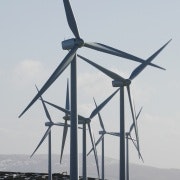Harvesting the whole solar spectrum
Significant improvements to the efficiency of solar cells could be possible in the near-future thanks to the recent development of a new heat-resistant thermal emitter by researchers at Stanford University.
The new heat-resistant thermal emitter was created as a means of converting the higher-energy portion of light into lower energy waves which can then be absorbed by the solar cells and converted into electricity, along with the lower energy portions that most solar cells convert. Technologies such as this – more broadly known as thermophotovoltaics – have been around for quite some time, but have, until now, possessed a number of important limitations that this new device seems to overcome.
Foremost of which, are the limitations to do with operating temperature ranges – earlier designs have all become nonfunctional at temperatures of around 2200 degrees Fahrenheit (1205 degrees Celsius), whereas the new one “remains stable at temperatures as high as 2500 F (1371 C)”.

The cross-section micrographs of a tungsten thermal emitter used in the experiment. The top image shows how unprotected tungsten degrades after heating to 1200 degrees Celsius. The bottom image demonstrates how the ceramic-coated tungsten retained structural integrity after being subjected to 1400 C heat for an hour. (Image credit: Kevin Arpin).
“This is a record performance in terms of thermal stability and a major advance for the field of thermophotovoltaics,” stated Shanhui Fan, a professor of electrical engineering at Stanford University. The new findings are the product of a collaboration between Fan and colleagues at the University of Illinois-Urbana Champaign and North Carolina State University.
The significance of the new device is, of course, that now a potentially much larger portion of the solar spectrum can be harvested by an individual solar cell.
“In theory, conventional single-junction solar cells can only achieve an efficiency level of about 34 per cent, but in practice they don’t achieve that,” stated study co-author Paul Braun, a professor of materials science at Illinois. “That’s because they throw away the majority of the sun’s energy.”
Stanford University explains:
“Essentially, we tailor the light to shorter wavelengths that are ideal for driving a solar cell,” Fan continued. “That raises the theoretical efficiency of the cell to 80 per cent, which is quite remarkable.”
As of now, though, that 80 per cent theoretical limit is quite a ways off – the peak achieved so far has been an efficiency level of about 8 per cent. The reason for the disparity is primarily because of problems with the intermediate component, which is typically made of tungsten, according to the researchers. To address this issue, the researchers coated the tungsten emitters in a nanolayer of a ceramic material called hafnium dioxide, greatly improving their heat tolerance.
“The results were dramatic. When subjected to temperatures of 1800 F (1000 C), the ceramic-coated emitters retained their structural integrity for more than 12 hours. When heated to 2500 F (1400 C), the samples remained thermally stable for at least an hour.”
“These results are unprecedented,” stated lead author Kevin Arpin. “We demonstrated for the first time that ceramics could help advance thermophotovoltaics as well other areas of research, including energy harvesting from waste heat, high-temperature catalysis and electrochemical energy storage.”
“We’ve demonstrated that the tailoring of optical properties at high temperatures is possible,” Braun added. “Hafnium and tungsten are abundant, low-cost materials, and the process used to make these heat-resistant emitters is well established. Hopefully these results will motivate the thermophotovoltaics community to take another look at ceramics and other classes of materials that haven’t been considered.”
The new research was just published in the October 16th edition of the journal Nature Communications.
Originally published by CleanTechnica. Republished with permission.













